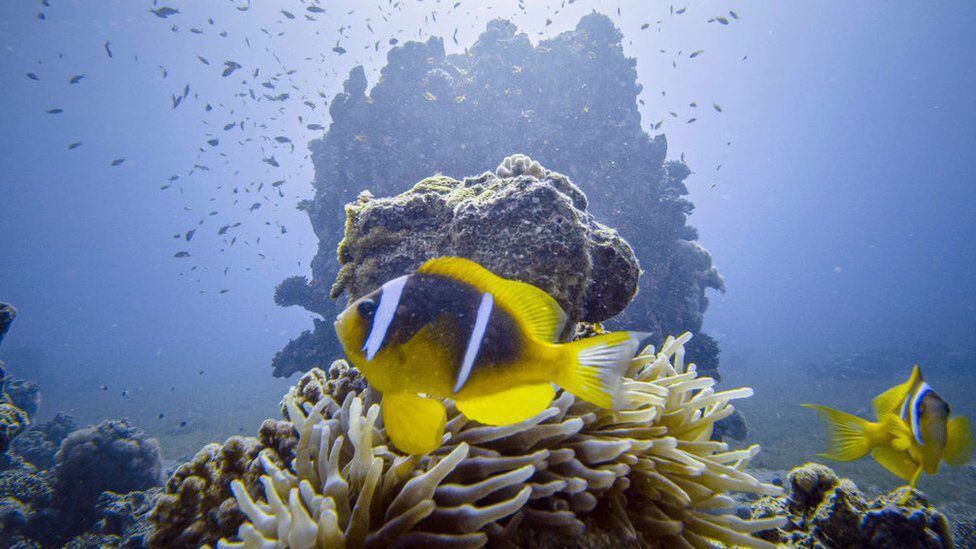The recent sharp and unexpected rise in ocean temperatures has alarmed scientists, who admit they are concerned about its long-term impact on global warming.
This month, the sea surface reached a new temperature record, but what is most striking is that it has never warmed so much or so fast.
LOOK: What consequences can the powerful El Niño phenomenon have that scientists forecast for the coming months
Scientists don’t quite understand why.
The concern is that, combined with other weather events, global temperature may reach an extremely disturbing level by the end of next year.
One of these phenomena is what is known as The boy, a weather system that warms the ocean, which experts believe this year will be very intense.
The problem is that rising ocean temperatures could wipe out marine life, cause more extreme weather events, and raise sea levels.
Furthermore, it makes the oceans less efficient at absorbing the greenhouse gases that warm the planet.
huge differences
An important new study, which was published last week, highlighted a troubling fact.
In the last 15 years, the accumulated heat on Earth has increased by 50%and most of that increase has gone into the oceans.
This is having real consequences globally: not only did the global ocean temperature reach a new record in April of this year, but in some regions the difference compared to other times in the past was enormous.
As an example, sea surface temperatures off the east coast of North America were mentioned, which in March exceeded the average recorded between 1981-2011 by 13.8°C.
“It is not yet well established why such a rapid and great change is taking place.said Karina Von Schuckmann, lead author of the new study and an oceanographer with the Mercator Ocean International research group.
“We’ve doubled the heat in the climate system in the last 15 years. I don’t want to say this is climate change, natural variability, or a mix of both. We don’t know yet. But we do see this change.”
Secondary effect
One factor that could be influencing the level of heat reaching the oceans is, curiously, the reduction in pollution from shipping.
In 2020, the International Maritime Organization launched a regulation to reduce the sulfur content in the fuel burned by ships.

This has had a rapid impact, reducing the amount of aerosol particles released into the atmosphere.
But the aerosols that make the air dirty also help reflect heat back into space, so their removal may have caused more heat input into the waters.
Another major factor that worries scientists is the ENSO (El Niño-Southern Oscillation) weather pattern.
For the past three years, this natural phenomenon has been in a cooler phase called La Niña, and has helped keep global temperatures in check.
But the researchers they now believe a powerful El Niño is forming It will have major consequences for the world.
“There is a firm commitment to a strong El Niño. And all the climate models point in that direction,” said Hugh McDowell of the Australian Bureau of Meteorology.
Although McDowell considers that the predictions at this time of the year are less reliable, other researchers are more convinced of what is to come.
Especially since an El Niño phenomenon has already occurred on the coasts of Peru and Ecuadorwhich experts believe will be followed by a full blown event with consequences for global temperatures.
“If a new El Niño occurs on top of that, we will probably have an additional global warming of 0.2-0.25°C”said Josef Ludescher of the Potsdam Institute for Climate Research.

Up and down
According to Ludescher, “the impact on temperature usually subsides a few months after peaking when El Niño occurs, so 2024 will probably be the warmest on record.”
“And it may be that we are approaching the days of 1.5°C {the temperature increase that scientists have established as the maximum level allowed to slow down global warming} and we may temporarily go too far.”
El Niño is likely to disrupt weather patterns around the world, weaken the monsoon season and threaten Australia with more bushfires.
But what is most worrying is that as more heat enters the ocean, the waters are less able to store excess energy.
And there is also concern that the heat contained in the oceans does not remain there.
Various scientists contacted for this article were reluctant to discuss the implications in detail.
One said he was “extremely worried and completely stressed out.”
Some research has shown that global warming occurs in bursts, with little change over a period of years and then sudden upward jumps, closely linked to the development of El Niño.
It is a scenario that, according to Karina Von Schuckmann, gives some hope that temperatures will drop again after El Niño ends.
“We still have a window in which we can act and we should use it to reduce the consequences,” he told the BBC.
What consequences does the warming of the oceans have?
The average surface temperature of the world’s seas has risen by about 0.9°C compared to pre-industrial levels, of which 0.6°C has occurred in the last 40 years alone.
This rise is less than that of air temperatures over land, which has risen by more than 1.5°C since pre-industrial times. This is because it takes much more energy to heat water than land, and the oceans absorb heat far below their surface.
Even this seemingly small average increase has important real-world consequences.
Source: Elcomercio
I am Jack Morton and I work in 24 News Recorder. I mostly cover world news and I have also authored 24 news recorder. I find this work highly interesting and it allows me to keep up with current events happening around the world.

:quality(75)/cloudfront-us-east-1.images.arcpublishing.com/elcomercio/QWMK4MGTGVFCXPHF55WHGFRO5Q.jpg)

:quality(75)/cloudfront-us-east-1.images.arcpublishing.com/elcomercio/LDCA3MNU5FF5JJDIB7WFSF2UEY.jpg)
:quality(75)/cloudfront-us-east-1.images.arcpublishing.com/elcomercio/HVKHEAEGJVDH7ITEZECXDZHDWU.jpg)
:quality(75)/cloudfront-us-east-1.images.arcpublishing.com/elcomercio/3Y5UCERRZZFS3I7MZUEFEOHG4U.jpg)
:quality(75)/cloudfront-us-east-1.images.arcpublishing.com/elcomercio/5FK22BPG6BE4BCPEXITJWHEKJU.jpg)
